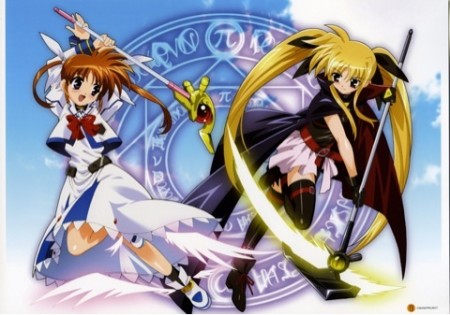Ask John: Why Did Lyrical Nanoha Flop in America?

Question:
What exactly makes the Lyrical Nanoha franchise so successful in Japan but unsuccessful in America compared to other mahou shoujo franchises like Sailor Moon, Madoka Magica, and Cardcaptor Sakura?
Answer:
Actually, one need only watch the 2004 Magical Girl Lyrical Nanoha anime series or its condensed first feature film to comprehend why its so unique. And it’s particularly that uniqueness that contributed to the series’ reception in Japan and America. Magical girl anime from the early 1960s through the 1980s were almost entirely focused on young girls using magic and transforming themselves to solve simple domestic troubles and satisfy themselves. From 1966’s Mahoutsukai Sally to 1990’s Idol Tenshi Youkoso Yoko & Mahou no Angel Sweetmint, magical girls rarely ever fought against evil, and even series like Minky Momo that did revolve around a magical girl defending the world from harm story didn’t actually emphasize that plot aspect. The 1992 Sailor Moon anime aggressively established the concept of magical girl soldiers in television anime. But Sailor Moon and its descendants like Wedding Peach, Tokyo Mew Mew, and even Cardcaptor Sakura, simply re-targeted traditional magical girl spells from the caster onto the antagonist. The 2004 Pretty Cure television series introduced a hybrid of mahou shoujo anime for girls imbued with the intense martial arts fighting of the shounen anime Dragon Ball Z, but Pretty Cure was, at heart, still a traditional magical girl anime targeted at preadolescent girl viewers. Lyrical Nanoha, however, was never a shoujo anime. Unlike Pretty Cure, which aired on Sunday mornings – prime children’s viewing time – Lyrical Nanoha aired at half-past midnight, signifying that it was a show intended for conventional young adult male otaku. Lyrical Nanoha disposed of the traditional magical girl tongue-twister spell chants and incantations and abandoned the idea of young girls casting magic on themselves. Furthermore, Lyrical Nanoha abandoned the magical girl anime tradition of offense magic that harmlessly purified or awakened foes. Lyrical Nanoha took a page from the devestating beam weapons of the Gundam franchise, introducing cataclysmic, destructive laser beams and gun-like weapons.
Arguably for the first time since 1973’s Cutey Honey, Japanese otaku had a magical girl television series consciously designed specifically for them instead of for little girl viewers. Lyrical Nanoha evoked the tropes of magical girl anime that male otaku were familiar with – a cute talking animal sidekick, magical costume change sequence, magical items – but made them relevant to young adult men. Unlike the later Puella Magi Madoka Magica series that was also targeted at male Japanese otaku, Lyrical Nanoha didn’t try to undermine or deconstruct the magical girl tradition. Lyrical Nanoha was literally a traditional girls’ magical girl anime imbued with an intensity and focus that appealed to boys. Madoka Magica, on the other hand, was a highly stylized, eclectic, literate re-evaluation and deconstruction of the conventions of the magical girl genre that sought to question and challenge the tropes of the genre instead of just employ them. So Lyrical Nanoha was successful in Japan because of its uniqueness and because it simply made the familiar more accessible to a new audience.
America, however, has not had a forty-year tradition of magical girl anime. American male otaku have not grown up exposed to countless repetitions of similar magical girl tropes. Japanese otaku have an established tradition of young adult men obsessing over cute little anime girls dating back to at least the mid 1980s. American otaku, especially in 2008, were in the middle of a conflicted love/hate relationship with moé anime and the very idea of male viewers empathizing with very feminine adolescent female characters. Typical American fans did not have a sublimated desire to watch little girls’ anime, or watch adorable little anime girls beat each other senseless, which explains why 1999’s D4 Princess television series likewise never caught on in America. Compounding the lack of widespread American desire for a show in the vein of Lyrical Nanoha, the series was licensed and dubbed by Geneon but released post-mortem. The first two Lyrical Nanoha television series received limited release thanks to FUNimation a year after Geneon ceased business operations. FUNimation invested minimal effort into promoting the title and distributed a relatively small number of DVD copies, contributing to a self-fulfilling prophecy of failure.
Typical, traditional magical girl anime targeted at girls, like Sailor Moon and Cardcaptor Sakura, have found their audience in America. These shows have proven popular with female viewers and attained some cross-over attention from male viewers. Madoka Magica, a show targeted at male viewers and superficially clothed in the appearance of a girls’ magical girl anime, likewise found its niche. Shows that fall in-between for one reason or another, like Lyrical Nanoha, Shoujo Kakumei Utena, and Akihabara Denno Gumi, have become tremendously successful in Japan but have struggled to find a receptive audience here in America. Japanese fans seem to appreciate the occasional show that crosses demographic lines. American viewers, however, largely seem to prefer shows that are either obviously made for female viewers or shows that are made for male viewers – not shows with an ambiguous gender identity, and especially not shows like Lyrical Nanoha, D4 Princess, and Akihabara Cyber Team that target male viewers by evoking female children’s programming stereotypes.

